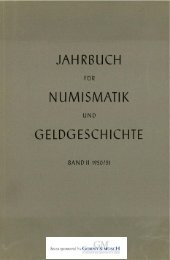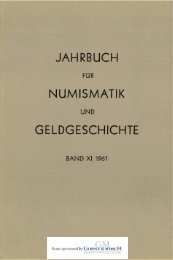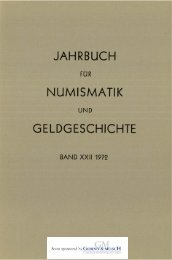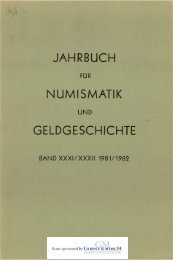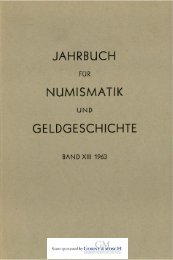16 J.Elayi, A.G.Elayitherefore designate the years this king ruled'9. It is likely that this system wasalso used for the previous abbreviations. On the other hand, this kind ofdating is well attested elsewhere in Phoenician inscriptions20. Moreover, twocoins from Tell Abu Hawam hoard21 support this hypothesis: a die used tomint shekels with 4T was reengraved with 6T, which seems to indicate adiscontinuous numbering according to a local era. Moreover, in the series includingfigures, the frequent absence of the first numbers confirms that thereis no continuous numbering.Because of the lack of documentation on the city of Tyre in this period,it is impossible to understand the meaning of all the abbreviations, but wecan understand which system was followed. The volume of Tyrian issuesprogressively increases as it can be seen by the increasing number of Tyriancoins in the hoards and the more and more regular dating: the Tyrian issueseven seem to become yearly at least from 350. We notice that, from the secondseries onwards, the coins are uninscribed only when there is no possibleconfusion between two successive issues. It would appear that there was apermanent preoccupation of differenciating each issue from the previousone, which became ever more necessary as the issues became morenumerous.The coins of the series of Phoenician standard, bearing the god on theseahorse could not be confused with the semi-incuse uninscribed coins of theprevious series because of iconographical and technical changes22: thus canbe explained their uninscribed character. But the following issues could beconfused with the previous one: consequently they bear the letters SR(?)23,M, MB and B24. We do not know whether these last letters already designatedthe initial of the kings' names or whether they were simply used in orderto distinguish the issues with an obscure meaning. If they already designatedthe initial of the kings' names, M and B would represent the two kings'issues, with the addition of Letter B (name of crown-prince?) on the second19 This series (up to 17) ends very likely in 333 (or some time before) because Alexander couldnot allow a rebellious city to continue the mint of her local coinage, symbol of herautonomy. Apart the proposal of E.T. Newell (The Dated Alexander Coinage of Sidon andAke, New Haven, 1916, p. 39 ss.) based only on stylistic grounds and generally admitted,there is no evident reason not to shift backwards (2 or 3 years) the beginning of the computof this series. This point will be developped in our book in preparation (cf. n. 2, above).20 KAI 14, 1. 1; J.C. Greenfield, „A Group of Phoenician City Seals", IEJ 35 (1985), pp.129-134 (the number may designate the regnal year following the abbreviation of theking's name).21 C. Lambert, „A Hoard of Phoenician Coins", QDAP 1 (1931), p. 15, n° 5, 8.22 Babelon, Perses, n° 1980, 1996.23 BN Paris, Coll. de Luynes, n° 3212; the lecture of the name of the city is uncertain.24 BMC Phoenicia, p. 229, n° 11, 13; Lambert, loc. cit., n° 13.
Abbreviations Used by Byblos,Tyre and Arwad 17issue of King M25. Figures would then have been introduced by King B inorder to differenciate, by years of rule, issues which became more frequent.7B was possibly used in order to distinguish two issues during the seventhyear of his rule26. Figures seem to have been used alone because there wasno possible confusion, since they appeared for the first time. Kings T andZ followed the system of King B27, the first with at least two issues up tothe VIth year of his rule and the second with at least five issues up to theXIIIth year of his rule.Later, thinner flans were used, and the coins were uninscribed since the inscriptionwas not necessary for differenciating the new issue28. Once theorientation of the owl was changed, there was probably first an uninscribedissue; subsequently, it was sufficient to inscribe the regnal year on its ownin order to differenciate the issues29. 1 and BI (B (ST) 1, „in the first year"were probably issued in order to distinguish two different issues during thefirst year. Then King Z seems to have added his initial because the coins retainedthe same type. King M possibly began to issue coins with the type ofthe owl turned to the left with M, without a number for his accession year.During the same year, he minted a second issue with the owl turned backto the right: M was sufficient to differenciate this issue. Then, during the firstyear of his rule, he seems to have made two issues Ml and Bml. The meaningof B, which was used in order to differenciate the second issue, is probablyB [ST] 1, „in the first (year)". During the second year, there may have beenthe issue M2, and during the third year two issues: M3 and M'3 (the meaningof ' is not clear)". Afterwards the coins of King S may have been minted upto the sixth year of his rule31. They were followed by the coins of the lastking ' (Azemilkos?) since they are inscribed together on one of the two issuesof the third year of King S' rule (`s3)32.25Of course, we shall not propose names from the initial since there are many possibilitiesand non-numismatic sources do not give any information.26 Baramki, op. cit., p. 220. n° 8.27SNG Copenhague, n° 300; Lambert, loc. cit., n° 5.28BN Paris, Coll. de Luynes, n° 3218.29 BMC Phoenicia, p. 231, n° 31.30 Kindler, loc. cit., pp. 323-324.31Number 6 is not sure: cf. Lemaire, loc. cit., p. 12, n.l.32BMC Phoenicia, p. 232, n° 33. As far as the series with S and a figure is concerned, anotherhypothesis can also be proposed: it could correspond to the period following the revolt ofTyrian slaves (J. Elayi, „La revolte des esclaves de Tyr relatee par Justin", JANES 12 [1981],pp. 139-150). S would be the initial of the city of Tyre (H. Seyrig, „Antiquites syriennessur une pretenclue ere tyrienne", Syria 34 [1957], p. 96); ' would designate King `Abd`gtart(Strato) saved by the slaves and father of King `Ozmilk to whom belongs the last Tyrianseries with ' and a number.
- Seite 1: JAHRBUCHFÜRNUMISMATIKUNDGELDGESCHI
- Seite 5 und 6: JAHRBUCHFÜRNUMISMATIK UND GELDGESC
- Seite 7 und 8: INHALTVorbemerkung der Redaktion 7G
- Seite 9: 7Vorbemerkung der RedaktionEntgegen
- Seite 12 und 13: 10 Gerd DethlefsDie Zeichnung befin
- Seite 14 und 15: 12 J.Elayi, A.G.Elayiexplicit inscr
- Seite 16: 14 J. Elayi, A.G.Elayione bears on
- Seite 21 und 22: Abbreviations Used by Byblos,Tyre a
- Seite 23 und 24: Abbreviations Used by Byblos,Tyre a
- Seite 25 und 26: Jahrbuch f. Numismatik u. Geldgesch
- Seite 27 und 28: Significance of „Boiotian League/
- Seite 29 und 30: Significance of „Boiotian League/
- Seite 31: Significance of „Boiotian League/
- Seite 34 und 35: 32 Peter F. Dorceycoinage. Accordin
- Seite 36 und 37: 34 Peter F. Dorceyquem of 120.'° A
- Seite 38 und 39: 36 Peter F.DorceyEETI(AI)2° and HP
- Seite 40 und 41: 38 Peter F. DorceyTable I: Catalogu
- Seite 42 und 43: 40 Peter F.DorceyTable II: Coin Hoa
- Seite 44 und 45: 42 Allan A. LundDer Germanenbegriff
- Seite 46 und 47: 44 Allan A. Lundnen sie, wie die Fo
- Seite 48 und 49: 46 Allan A. Lunddie Angaben über d
- Seite 50 und 51: 48 Allan A. Lundw a 200 Kilometer b
- Seite 52 und 53: 50 Allan A. Lundrelle Grenze fielen
- Seite 55 und 56: Jahrbuch f. Numismatik u. Geldgesch
- Seite 57 und 58: Ein weiterer Aureus des Pescennius
- Seite 59 und 60: Jahrbuch f. Numismatik u. Geldgesch
- Seite 61 und 62: 1Bronzeprägung von Laodikeia in Sy
- Seite 63 und 64: Bronzeprägung von Laodikeia in Syr
- Seite 65 und 66: Bronzeprägung von Laodikeia in Syr
- Seite 67 und 68:
Bronzeprägung von Laodikeia in Syr
- Seite 69 und 70:
Bronzeprägung von Laodikeia in Syr
- Seite 71 und 72:
Bronzeprägung von Laodikeia in Syr
- Seite 73 und 74:
Bronzeprägung von Laodikeia in Syr
- Seite 75 und 76:
Bronzeprägung von Laodikeia in Syr
- Seite 77 und 78:
Bronzeprägung von Laodikeia in Syr
- Seite 79 und 80:
Bronzeprägung von Laodikeia in Syr
- Seite 81 und 82:
Bronzeprägung von Laodikeia in Syr
- Seite 83 und 84:
Bronzeprägung von Laodikeia in Syr
- Seite 85 und 86:
Bronzeprägung von Laodikeia in Syr
- Seite 87 und 88:
Bronzeprägung von Laodikeia in Syr
- Seite 89 und 90:
Bronzeprägung von Laodikeia in Syr
- Seite 91 und 92:
Bronzeprägung von Laodikeia in Syr
- Seite 93 und 94:
Bronzeprägung von Laodikeia in Syr
- Seite 95 und 96:
Jahrbuch f. Numismatik u. Geldgesch
- Seite 97 und 98:
Zwei Bleigewichte in München 95mei
- Seite 99 und 100:
Zwei Bleigewichte in München 97Val
- Seite 101 und 102:
Zwei Bleigewichte in München 99nö
- Seite 103 und 104:
Jahrbuch f. Numismatik u. Geldgesch
- Seite 105 und 106:
Saalfeld als Münzstätte der Leini
- Seite 107 und 108:
Saalfeld als Münzstätte der Leini
- Seite 109 und 110:
Saalfeld als Münzstätte der Leini
- Seite 111 und 112:
Saalfeld als Münzstätte der Leini
- Seite 113 und 114:
Saalfeld als Münzstätte der Leini
- Seite 115 und 116:
Saalfeld als Münzstätte der Leini
- Seite 117 und 118:
Saalfeld als Münzstätte der Leini
- Seite 119 und 120:
Saalfeld als Münzstätte der Leini
- Seite 121 und 122:
Saalfeld als Münzstätte der Leini
- Seite 123 und 124:
Saalfeld als Münzstätte der Leini
- Seite 125 und 126:
Saalfeld als Münzstätte der Leini
- Seite 127 und 128:
Saalfeld als Münzstätte der Leini
- Seite 129 und 130:
Saalfeld als Münzstätte der Leini
- Seite 131 und 132:
129ZUSAMMENFASSUNGEN(erstellt von B
- Seite 133 und 134:
Zusammenfassungen/Conclusions 131Ar
- Seite 135 und 136:
Jahrbuch f. Numismatik u. Geldgesch
- Seite 137 und 138:
Buchbesprechungen, Jb.f.Num.u.Geldg
- Seite 139 und 140:
Buchbesprechungen, Jb.f.Num.u.Geldg
- Seite 141 und 142:
Buchbesprechungen, Jb.f.Num.u.Geldg
- Seite 143:
Buchbesprechungen, Jb.f.Num.u.Geldg
- Seite 146 und 147:
144 Jahresbericht Staat!. Münzsamm
- Seite 149 und 150:
Jahrbuch f.Numismatik u. Geldgeschi
- Seite 151 und 152:
Jahresbericht B.N.G. 149Stadt lasse
- Seite 153:
Jahresbericht B.N.G. 151Band 35, k
- Seite 156 und 157:
154 Jahresbericht B.N.G.der Heimat
- Seite 158 und 159:
156 Jahresbericht B.N.G.Medaillen"
- Seite 161 und 162:
vyaltoti9er canyexitift, _s,9t.czr
- Seite 163 und 164:
Tafel 3123Zu: J. und A.G. Elayi, Sy
- Seite 165:
Tafel 5Zu: Peter F. Dorcey, The Pos
- Seite 169 und 170:
Zu: Eckhard Meyer, Die Bronzeprägu
- Seite 171 und 172:
Elf el 949Zu: Eckhard Meyer, Die Br
- Seite 173 und 174:
Zu: Eckhard Meyer, Die Bronzeprägu
- Seite 175 und 176:
Zu: Eckhard Meyer, Die Bronzeprägu
- Seite 177 und 178:
Zu: Eckhard Meyer, Die Bronzeprägu
- Seite 179 und 180:
Zu: Eckhard Meyer, Die Bronzeprägu
- Seite 181 und 182:
Tafel 19Maßstab:1 : 1Foto: Staatl.
- Seite 183 und 184:
Tafel 211 2 34 5. , )(4. ' cili li





